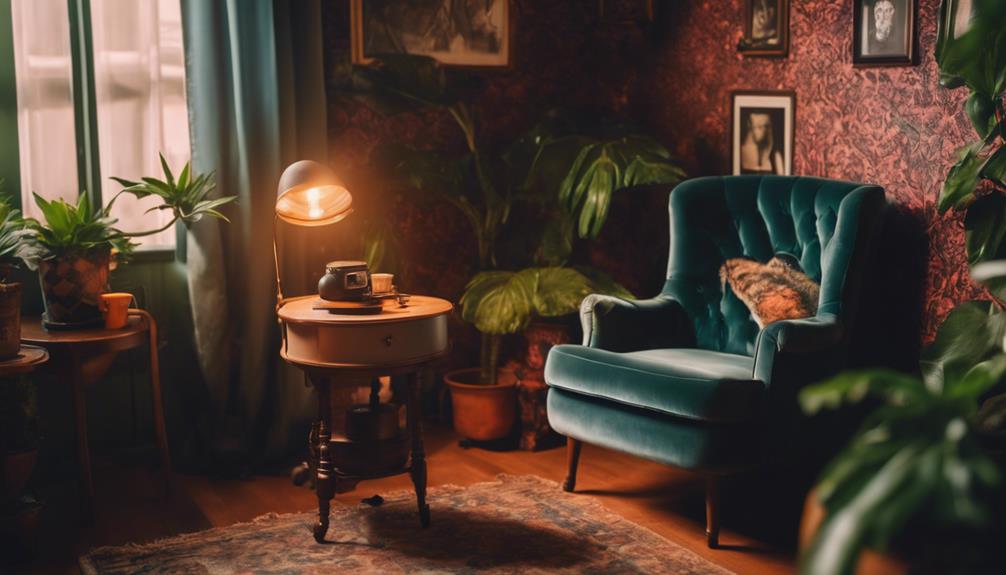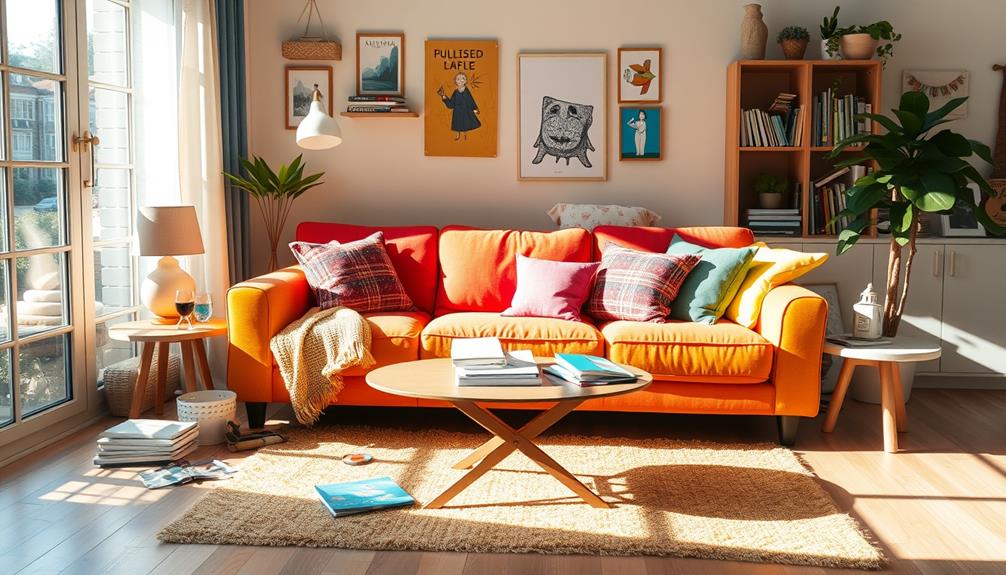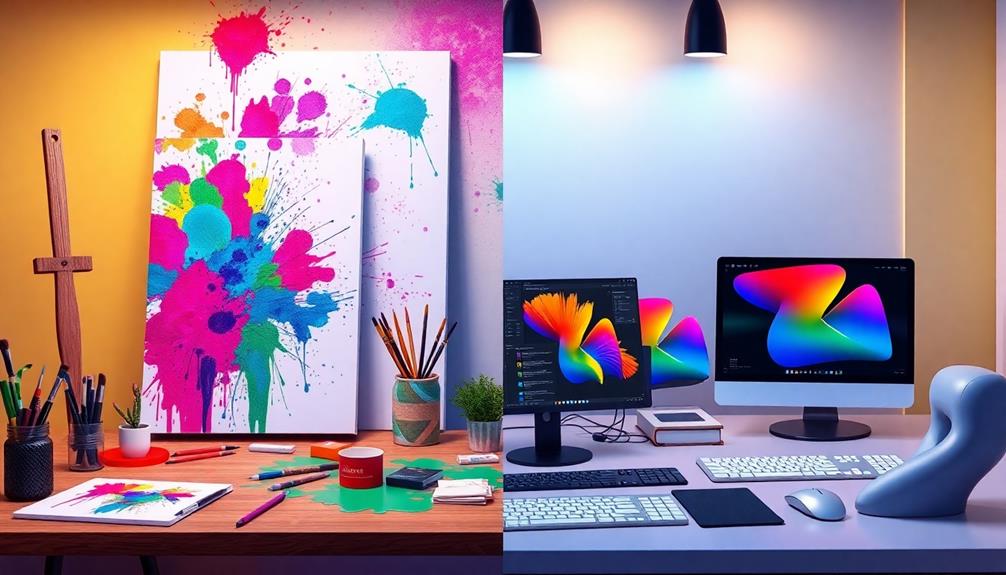To create a stunning vintage room that captures attention, begin with a unified color scheme featuring earthy tones and vibrant accents. Integrate distressed wooden furniture and unique vintage fabrics, such as handcrafted quilts. Remember to include vintage lighting – like Edison bulbs and elegant chandeliers – to enhance the atmosphere. Incorporate decorative touches like porcelain figurines and floral wall art that recount a narrative. For the flooring, consider distressed hardwood or patterned vintage tiles to enhance the overall appeal. By embracing these concepts, your vintage room will exude a nostalgic charm that everyone will admire. There is plenty more to discover to achieve the perfect vintage look!
Key Elements
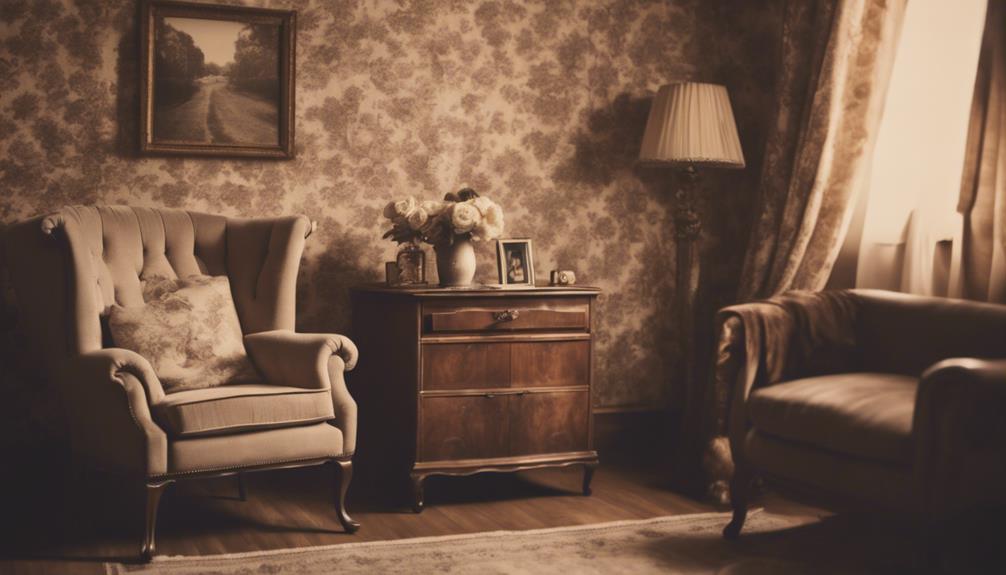
When creating a vintage room, your color scheme plays an essential role in setting the mood.
You'll want to choose materials and textures that evoke nostalgia, like soft linens and rich woods.
Together, these elements create a cohesive and inviting space that feels both timeless and charming.
Color Scheme
A cohesive color palette is essential for vintage room design, as it harmonizes the interplay between vintage and modern elements.
Start with neutral tones as your foundation; they serve as a versatile backdrop that allows other colors to shine. Incorporating earthy hues can create warmth and depth, while bold accent colors energize the space. Soft pastels can evoke a serene atmosphere, enhancing the overall vintage aesthetic.
Vintage wallpaper is a fantastic way to introduce unique patterns and charm, providing a glimpse into the historical context of the era you're emulating. When selecting wallpaper, consider how its colors will interact with your chosen color scheme.
Layering textures through various textiles, like vintage quilts, lace curtains, and patterned rugs, adds visual interest and depth to your room.
Don't forget about color blocking techniques to demarcate different areas within the room while maintaining a cohesive flow. This approach contributes to a balanced and inviting environment, ensuring that each element complements the others.
Materials
Incorporating materials like distressed wood, wrought iron, and soft textiles elevates the vintage aesthetic, creating a warm and inviting atmosphere in your room.
Start with vintage furniture pieces that exude character; think charming side tables or a well-loved rocking chair. Pair these with vintage textiles, like handmade quilts from Etsy, to bring in classic colors and patterns that tell a story.
Don't overlook the importance of vintage rugs. A durable wool rug can add both warmth and texture to your space, while also showcasing craftsmanship that's stood the test of time.
Vintage lighting fixtures, such as ornate chandeliers or charming table lamps made from glass and metal, can serve as stunning focal points, enhancing the room's nostalgic vibe.
Accessorize with antique furniture and distressed pieces to create a cohesive design that reflects your personal history. Antique picture frames can hold cherished memories and add a layer of depth to your decor.
Textures
Textures greatly enhance the vintage room aesthetic, weaving together layers of softness and character that invite both visual and tactile engagement. To create a truly inviting space, mix soft textiles like lace curtains, embroidered pillows, and handmade quilts. These elements add warmth and texture, making your vintage decor feel cozy and welcoming.
Incorporating various materials is key. Distressed wood furniture and wrought iron accents bring richness, while vintage ceramics add a nostalgic charm. Layering different textures—like plush rugs over hardwood floors and decorative throws on beds—creates dimension and encourages interaction with the space.
Don't underestimate the power of vintage wallpaper, either. Floral or damask patterns introduce intricate textures that can transform the feel of a room. Textured wall finishes, such as plaster or shiplap, evoke history and charm, enriching the vintage elements in your decor.
Essential Fixtures and Furniture
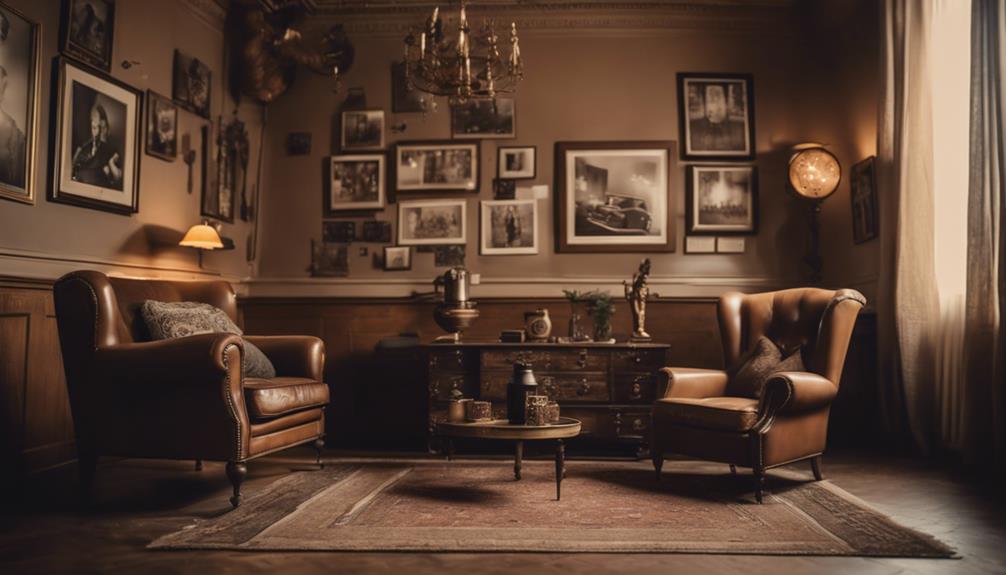
When it comes to essential fixtures and furniture for your vintage room, you'll want to focus on key pieces that truly stand out.
An antique brass bed frame can serve as a stunning focal point, while a vintage crystal chandelier adds elegance and a touch of glamour.
Don't forget vintage wall sconces to enhance the ambiance and provide warm, inviting lighting throughout the space.
Antique Brass Bed Frame
An antique brass bed frame transforms your vintage bedroom into a timeless sanctuary, showcasing intricate details and a warm glow that enhances any decor. This essential fixture adds a vintage aesthetic that makes any space feel inviting and rich with history. Often crafted during the 19th and early 20th centuries, these bed frames reflect an era of exquisite craftsmanship, ensuring that they serve as a striking focal point in your room.
The timeless charm of an antique brass bed frame isn't just about looks; its durability means it can last for generations, becoming a beloved piece in your home. You can find these stunning frames at antique shops, online marketplaces, and estate sales, with prices varying based on their condition and craftsmanship.
Incorporating an antique brass bed frame into your decor not only enhances the overall nostalgic charm of your bedroom but also creates a cozy retreat where you can unwind. Whether you pair it with vintage linens or modern accents, this bed frame will certainly elevate your space and leave everyone envious of your unique style.
Vintage Crystal Chandelier
A vintage crystal chandelier instantly transforms your space, adding a touch of elegance and a warm, inviting glow that fascinates anyone who enters. This stunning fixture not only serves as a focal point but also enhances the nostalgic aesthetics of your home. The intricate designs and hanging crystals refract light beautifully, creating an ambiance that's both cozy and luxurious.
When you incorporate a vintage crystal chandelier into your decor, you elevate the overall aesthetic of the room. It pairs perfectly with vintage-themed decor, adding a sense of grandeur that's hard to duplicate with modern lighting options. You can often find unique vintage pieces at antique shops, estate sales, or online marketplaces, offering a range of styles and price points to suit your taste.
As you install your chandelier, remember to reflect on the height for hanging. Proper installation guarantees it enhances your design while providing adequate lighting without obstructing views.
With the right vintage crystal chandelier, you'll create a fascinating atmosphere that everyone will envy, making your home a true reflection of timeless beauty.
Vintage Wall Sconces
Vintage wall sconces add both charm and functionality to your space, illuminating walls while enhancing the nostalgic atmosphere of your decor. These essential fixtures not only provide light but also serve as stunning decorative elements that can transform any room.
You'll find vintage wall sconces in a variety of styles, from intricate Art Deco to the minimalist lines of Midcentury Modern. When you incorporate these vintage finds, you draw the eye upwards, adding vertical interest to your walls.
Whether you opt for sconces designed for candlelight, which create a romantic ambiance, or those equipped with electric lighting for convenience, they'll maintain the vintage aesthetic you desire.
To find unique pieces that resonate with your style, explore local antique shops or flea markets. Online marketplaces like Etsy also offer a plethora of options, making it easy to discover the perfect vintage wall sconces that complement your decor.
Lighting Ideas
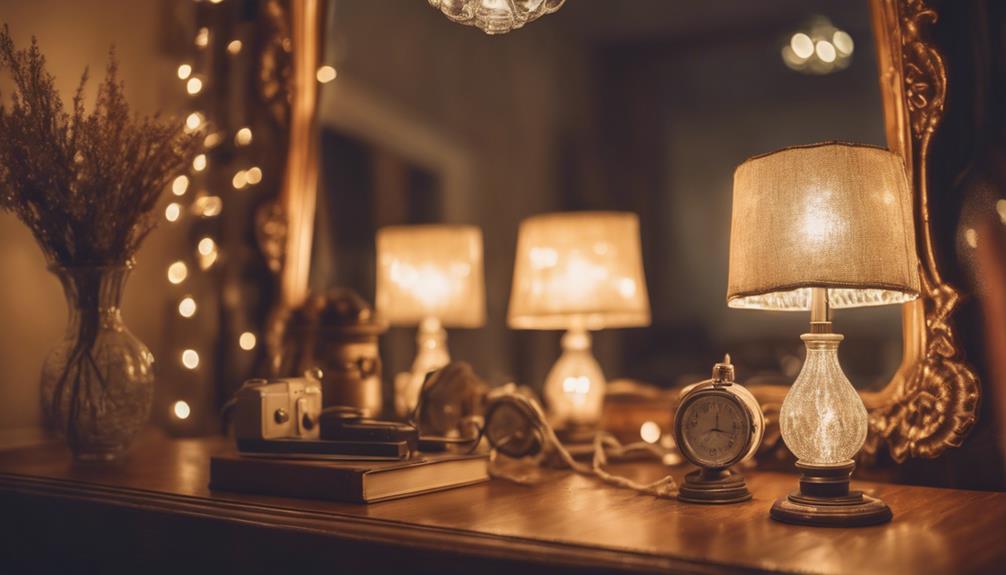
When it comes to lighting in your vintage room, you've got some exciting options to explore.
Consider incorporating vintage Edison bulb fixtures or antique-style table lamps to enhance the charm.
String lights or a fairy light canopy can also add a magical touch, creating a warm and inviting atmosphere.
Vintage Edison Bulb Fixtures
Exposed filament designs in Edison bulb fixtures bring a nostalgic charm to your vintage-inspired interiors, instantly elevating the ambiance of any room.
These vintage lighting fixtures come in various styles, including pendant lights, chandeliers, and wall sconces, giving you the flexibility to integrate them seamlessly into your decor. The warm glow of Edison bulbs enhances the cozy ambiance, making spaces feel inviting and comfortable.
When you combine these fixtures with other decor elements like distressed furniture and soft textiles, you truly capture that vintage aesthetic. Many of these fixtures are crafted from durable materials such as brass, wrought iron, or wood, which add character and longevity to your overall design.
Consider using dimmable Edison bulbs with these fixtures for adjustable lighting levels, enabling you to create the perfect mood for any occasion. Whether you're hosting a gathering or enjoying a quiet evening, the unique beauty of vintage lighting can transform your home into a nostalgic retreat.
Embrace the charm of vintage Edison bulb fixtures and watch as your space becomes a cozy haven that everyone will envy!
Antique-Style Table Lamps
Antique-style table lamps bring a timeless elegance to your decor, showcasing intricate designs that enhance any vintage-inspired space. These lamps often feature materials like brass or stained glass, adding an air of nostalgia to your home.
When you're on the hunt for unique finds, consider exploring flea markets, estate sales, or online marketplaces. You might discover charming pieces that add character and warmth to your vintage decor.
Many antique table lamps may require minor repairs, such as re-wiring or new shades, which can be an affordable way to refresh your lighting while preserving its charm. Incorporating dimmable antique lamps allows you to adjust the lighting to create a cozy atmosphere for any occasion.
To further enhance the nostalgic aesthetic, pair your antique-style table lamps with vintage-style bulbs like Edison or globe bulbs. Not only do these options provide a soft glow, but they also add a modern touch to your vintage finds.
With the right selection of antique-style table lamps, you can create an inviting and stylish ambiance that everyone will envy.
Vintage Lantern String Lights
Vintage lantern string lights effortlessly complement the charm of antique-style table lamps, adding a whimsical glow that transforms any space into a cozy retreat. These delightful lighting fixtures bring a nostalgic touch to your home, enhancing the vintage aesthetic you're aiming for. With their metal frames and glass enclosures, they evoke memories of simpler times while providing modern functionality.
You can easily drape these string lights across walls or ceilings, making them versatile decor ideas for both indoor and outdoor settings. Whether you're hosting cozy gatherings or enjoying a romantic evening at home, vintage lantern string lights create an inviting atmosphere that enchants your guests. Plus, with many options utilizing energy-efficient LED bulbs, you'll enjoy a longer-lasting illumination without compromising on style.
Consider using them to highlight a favorite artwork or to frame a doorway, instantly elevating your decor while keeping the space warm and inviting. Incorporating vintage lantern string lights into your home not only enhances your overall design but also fosters a sense of nostalgia that everyone will admire. Embrace the charm and warmth these lights bring, and watch your space transform into a haven of vintage allure.
Vintage Fairy Light Canopy
Transform your bedroom into a cozy retreat by creating a stunning vintage fairy light canopy that envelops your space in a magical glow. You can easily achieve this vintage bedroom idea by draping fairy lights over your canopy bed or along the ceiling. This not only infuses your room with a whimsical charm but also enhances the romantic ambiance.
To elevate the vintage decor, consider incorporating sheer fabrics or lace curtains. These materials soften the light, creating a gentle diffusion that adds to the enchanting atmosphere. Opt for warm white or soft yellow fairy lights, as they complement the muted color palettes typical in vintage styles, making your space feel inviting and nostalgic.
For an eye-catching focal point, layer different types of lights—think globe or Edison bulb string lights combined with delicate twinkle lights. This mix adds visual interest and depth to your canopy.
Best of all, installing your fairy light canopy is a breeze; simply use adhesive hooks or ceiling-mounted clips to secure your lights. With minimal effort, you can transform your bedroom into a dreamy sanctuary that everyone will envy!
Decorative Elements
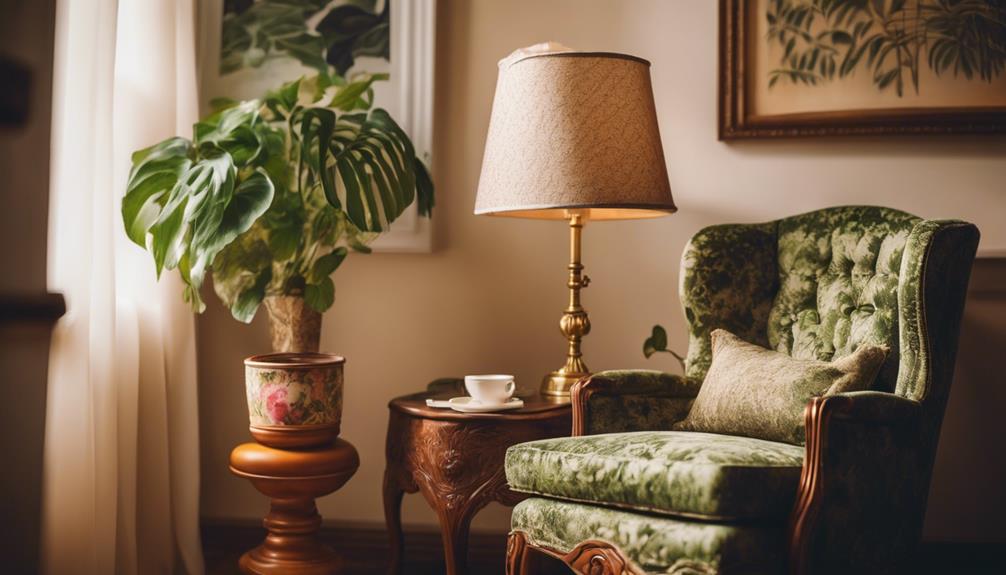
When you think about decorative elements for your vintage room, consider adding vintage floral wall art to bring a touch of nature indoors.
Incorporating vintage porcelain figurines can also add character and tell a story, while a lace table runner offers a delicate texture that ties the room together.
These elements not only enhance the aesthetic but also create a warm, inviting space.
Vintage Floral Wall Art
Floral wall art brings a timeless charm to your space, utilizing soft colors and intricate designs that create a warm and inviting atmosphere.
Vintage floral wall art often showcases muted colors that evoke nostalgia, making it perfect for vintage aesthetic bedrooms. Incorporating framed antique floral prints or botanical illustrations enhances the vintage charm of your room, adding character and a touch of nature to your decor.
For a statement feature wall, consider using patterned wallpaper with vintage floral motifs; it instantly transforms a space and adds depth to your overall aesthetic. The versatility of vintage floral wall art, ranging from oil paintings to delicate prints, allows you to complement various vintage furniture and accessories effortlessly.
When sourcing these unique pieces, don't forget to explore thrift stores, flea markets, or online platforms like Etsy. You'll discover affordable options that reflect your personal style while maintaining the essence of vintage charm.
Vintage Porcelain Figurines
Vintage porcelain figurines add a unique touch to your decor, complementing the charm of floral wall art while introducing a new layer of sophistication and nostalgia.
These vintage pieces, often produced in limited quantities, showcase intricate craftsmanship and hand-painted details that enhance the overall aesthetic of your home. Whether you prefer whimsical designs or delicate collectibles, incorporating these figurines creates a cozy atmosphere that invites admiration.
You can position these unique vintage items on shelves, mantels, or within display cabinets, allowing them to serve as conversation starters. Choose themes that resonate with you—like animals or flowers—to further personalize your space. The vintage look of porcelain figurines pairs beautifully with decorative pillows, softening edges and adding layers to your design.
As some figurines appreciate in value over time, they not only enrich your decor but also become cherished collectibles. By carefully selecting these vintage pieces, you'll create a harmonious blend of nostalgia and sophistication that everyone will envy.
Vintage Lace Table Runner
A vintage lace table runner instantly transforms your dining table, adding elegance and a touch of nostalgia to any meal. Perfect for creating a warm atmosphere, it enhances your dining spaces, making even casual dinners feel special. Crafted from delicate materials like cotton or linen, these runners feature intricate patterns that elevate your table setting.
You can find unique vintage lace table runners in thrift stores, antique shops, or online marketplaces, each piece reflecting a distinct personal style and history. When you layer a lace runner over a solid tablecloth, you create a charming juxtaposition that enriches your vintage home decor. Pair it with vintage dishware for an even more cohesive look.
To keep your vintage lace table runner beautiful, regular cleaning and gentle care are essential. Hand washing or using delicate cycles will help preserve its integrity over time.
Flooring

When choosing flooring for your vintage room, consider distressed hardwood floor planks to add warmth and character.
Antique-inspired area rugs can enhance the cozy vibe while patterned vintage tile flooring offers a unique visual appeal.
Mixing these materials not only elevates the aesthetic but also creates an inviting atmosphere.
Distressed Hardwood Floor Planks
Distressed hardwood floor planks bring a rustic charm to any space, enhancing the cozy, inviting atmosphere that complements vintage decor. These planks often come from reclaimed wood, which not only adds character and history to your home but also promotes environmental sustainability. The unique distressed finish showcases scuffs, marks, and weathered textures, enriching the overall vintage feel of your room.
When you choose distressed hardwood, you create a warm backdrop for your antique decor, allowing each piece to stand out while harmonizing with the overall aesthetic. Installation costs typically range from $5 to $15 per square foot, depending on the wood species and the extent of the distressing process.
To maintain the beauty and longevity of your distressed hardwood floor planks, regular upkeep is essential. Simple tasks like sweeping and occasional refinishing will keep your floors looking gorgeous for years to come.
Antique-Inspired Area Rugs
Antique-inspired area rugs instantly transform your space with intricate patterns and rich colors that evoke nostalgia and timeless elegance. These rugs are perfect additions to vintage room decor, bringing warmth and texture to any setting.
When you incorporate vintage rugs, like Persian or Oriental designs, you not only define areas in open-concept layouts but also add a cozy atmosphere that invites comfort and conversation.
Contemplate layering antique-inspired rugs over hardwood floors or contemporary carpeting to create visual interest. This technique enhances the depth of your design while allowing you to play with different textures and patterns.
Just remember to take into account the maintenance requirements; these rugs may need special care to preserve their intricate designs and guarantee longevity.
When sourcing antique-inspired area rugs, opt for reputable retailers that offer durable yet affordable options that mimic the look of genuine vintage pieces. This way, you can enjoy the charm of antiques without compromising on quality.
Patterned Vintage Tile Flooring
How can patterned vintage tile flooring add a stunning focal point to your vintage-inspired room? It's simple: these tiles feature intricate designs and vibrant colors, instantly elevating the nostalgic charm of your space.
From geometric shapes to floral motifs, patterned vintage tile flooring offers a wealth of styles that beautifully complement the vintage elements you've chosen for your home.
Whether you're incorporating retro furniture or vintage textiles, the right tile can create a cohesive look that draws the eye. Plus, with materials like ceramic, porcelain, or terracotta, these tiles aren't only visually appealing but also durable and easy to maintain.
Finding the perfect vintage tiles is easier than you think. You can explore specialty antique shops, reclaimed materials suppliers, or even online marketplaces for unique flooring solutions that reflect your personal style.
What Makes Vintage Room Ideas Different from Indie Room Decor?
Vintage room ideas are characterized by a classic and timeless appeal, often featuring antique furniture, lace accents, and muted color palettes. On the other hand, unique indie room decor ideas embrace a more eclectic and bohemian vibe, with an emphasis on vibrant colors, mix-and-match patterns, and DIY elements.
Conclusion
Incorporating vintage room ideas into your home can transform your space into a nostalgic haven that everyone will admire.
By thoughtfully selecting key elements, essential fixtures, and lighting, you create an inviting atmosphere.
Don't forget to add those unique decorative touches and choose the right flooring to tie everything together.
Embrace the charm of the past and let your personality shine through.
With these tips, you'll craft a vintage-inspired room that's both stylish and enviable!
